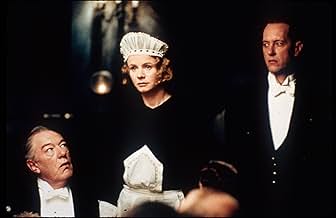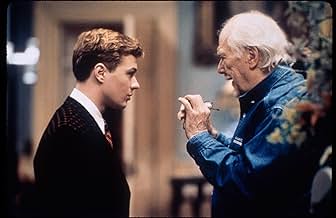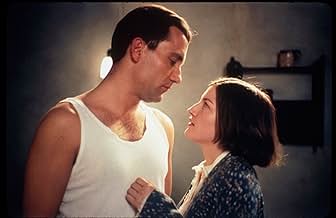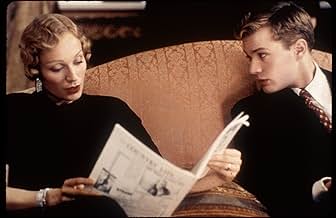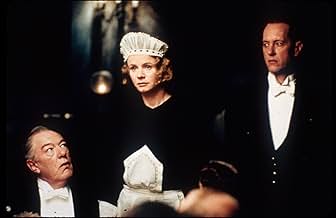Gosford Park
- 2001
- Tous publics
- 2h 17min
La vie des invités logeant à l'étage et des domestiques au rez-de-chaussée lors d'une fête en 1932 dans une maison de campagne en Angleterre alors qu'ils enquêtent sur le meurtre de l'un d'e... Tout lireLa vie des invités logeant à l'étage et des domestiques au rez-de-chaussée lors d'une fête en 1932 dans une maison de campagne en Angleterre alors qu'ils enquêtent sur le meurtre de l'un d'entre eux.La vie des invités logeant à l'étage et des domestiques au rez-de-chaussée lors d'une fête en 1932 dans une maison de campagne en Angleterre alors qu'ils enquêtent sur le meurtre de l'un d'entre eux.
- Réalisation
- Scénario
- Casting principal
- Récompensé par 1 Oscar
- 36 victoires et 74 nominations au total
Avis à la une
Altman's preferences for kaleidoscopic social observation has sometimes failed in the past due to the weight of its own ambition: multi-plotted and multi-charactered snapshots of time and place held together by loose ties or a general thematic framework. Sometimes it pays off spectacularly (Nashville); sometimes it flatters to deceive (Short Cuts).
It works well here due to the necessary discipline of the single location and the greater opportunities for interaction among the characters this affords. Add to that an exemplary cast of (mostly) British character actors and a knowing script by Julian Fellowes that gives Altman's keenly observant camera plenty of time to make its own points.
Rightly, Altman is less concerned with the murder mystery, which is almost an aside, than with the opportunity given by a shooting party at a 1930s stately mansion to observe the English aristocracy and their servants in social interaction.
Never happier than when involved in a bit of human anthropology, Altman lightly dissects the complexities and hierarchies which go on both above and below stairs; in which many subtle and unsubtle rituals are played out among groups of people who clearly dislike each other but are forced through circumstance, need or employment to observe the fundamental social practices required.
1932 is also a time of intruding change into the nature of the old English ruling classes, slowly disintegrating in this between-wars period and, in this case, largely reliant on the wealth of one particularly reluctant patron to keep them in furs and flunkies. In on this act comes the (to them) faintly odious whiff of 20th century new money, represented by Hollywood and popular culture. These intruders are kept in their place, but the message is clear - change is coming, and coming fast.
The muted colours and autumnal setting continue this theme of a world in terminal decline and of a group of characters keenly conscious of place and tradition yet also wearied and exhausted by it. Only at the very end, when fundamental change has occurred and many characters are left to face up to very different destinies do we see a bit of sunshine creeping in, heralding the dawn of a new era.
The cast are all excellent, with special mention deserving of Maggie Smith's effortless scene stealing as a bitchy but broke old Countess; the ever reliable Jeremy Northam as matinee idol Ivor Novello, well aware of his place in the great scheme of things and young Kelly Macdonald in the pivotal role of Smith's harassed maid who's inquisitiveness rattles a whole load of family skeletons.
The story moves on as the characters begin to establish their names and the audience learns their varying social status. The intertwining stories among the guests begin to surface and the audience begins to realize there is much more in this house than what meets the eye.
During the night one member of the elite group is killed. None of the guests seemed to be fazed by this event and are only upset by the inconvenience it sets up for their lives.
The only one troubled is Constance, Countess of Trentham's maid, Mary (Kelly McDonald). The story begins to focus on Mary, who discovers secrets among the visitors and leads the audience to solve the mystery.
The great aspect about this film is Robert Altman's abilities to bring the past to life. He pays excellent attention to detail and is able to recreate the feelings and morals during the time period. He emerges the audience into a film world filled with history and story. Throughout the film Altman visually shows the audience the contrast between social classes through his various shots, lighting techniques, and camera filters. His fluid camera movements visually portray foreshadowing and relationship among characters. These elements give the audience a complete understanding of the mood and atmosphere in the film.
I recommend this movie to anybody who has the patience to sit and focus on this excellent film. Although the beginning is appropriately slow moving and the characters names are difficult to remember, the payoff is worth the efforts. This movie is made for active film viewers and all Robert Altman fans.
One of the best aspects of film is how it illustrates that fine line dividing the master-servant social structures, and how often that line is crossed, reminding us that life is just a game of costumes and masks, and we're all the same underneath. While the story was reminiscent of Agatha Christie's Ten Little Indians, where it's the mystery that captivates the audience, Altman goes beyond the mystery with Gosford Park by using the murder as a vehicle to draw attention to the human condition and class hierarchy.
On the downside, but to no surprise to fans of Altman's work, the movie is often hard to follow. His style of filmmaking involves entanglements of characters and subplots that don't appear to have much to do with one another at first blush, and Gosford Park takes this to the next level. Here, the murder takes place at the climax of this confusion, leaving you rather disoriented in the middle of the 2-hour-plus drama. Fortunately, the tone loosens up when a comedy-dim police inspector basically gets nowhere in his investigation, but the pieces start coming together through the other characters. The good news is that it all seems to come together in the end in a way that didn't require grasping every detail of every scene.
Despite its intricacies and confusing moments, there is so much more to Gosford Park that makes it interesting and enchanting. While it is clearly a sophisticated piece of film work with impeccable acting, directing and design, don't stress about not keeping up with it all the time. Sit back and take it in, and you'll feel satisfied in the end.
GOSFORD PARK is an English Murder Mystery, set in the 1920's, featuring an All Star Cast, Directed by a 7 time Oscar nominee. It received critical acclaim in the year it was released (2001), earned 7 Oscar nominations (including Best Picture) and won the Oscar for Best Original Screenplay (Julian Fellowes...who would go on to create/write DOWNTON ABBEY).
Set in an English Country Manor, overseen by overbearing Lord William McCordle (Michael Gambon, the 2nd Albus Dumbledore in the Harry Potter films), GOSFORD PARK tells of the trials, tribulations, loves and death (yes, there's a murder) of a host of characters both Upstairs (the wealthy) and Downstairs (the servants).
And what a cast it is! Kristin Scott Thomas, Maggie Smith, Charles Dance, Jeremy Northam, Tom Hollander and Bob Balaban lead the group of the wealthy, while Helen Mirren, Alan Bates, Clive Owen, Kelly MacDonald, Eileen Atkins and Emily Watson head up the cast of servants below the stairs.
Both Maggie Smith and Helen Mirren were nominated for an Oscar for Best Supporting Actress for their work in this film (both losing to Jennifer Connelly for A BEAUTIFUL MIND).
Directed by Robert Altman (M*A*S*H, NASHVILLE), GOSFORD PARK is much of what you would expect from an Altman film...many, many people living their lives, sometimes intersecting with others, often times just going off on their own, tied together by the circumstances of being in this giant manor house on a weekend of a murder.
It is an ambitious, "Oscar bait" film that succeeds for the most part. And, if you are into the costumes, sets, Interior Design and intimate scenes of people talking, then you will be richly rewarded by this film.
I loved this film when it first came out and was anxiously looking forward to re-visiting it.
While I still liked it during this viewing, I did find the pacing to be languid and I started finding myself being frustrated by threads and character direction that just sort of petered out or ended all together with no real resolution. I know this was on purpose, for Altman would argue that this is what happens in real life, but I found this frustrating.
But this film has much, much going for it and if you haven't seen this - or haven't seen this in awhile - and are a fan of these types of films, then GOSFORD PARK will be a very rewarding 2 hours and 11 minutes of a movie going experience.
Letter Grade: B
7 stars (out of 10) and you can take that to the Bank (ofMarquis)
Bob Balaban and Robert Altmann story idea combined with Fellowes's eloquent writing is first rate. The dialogues are filled with wit, humour and subtle depth. The mansion itself plays a key character in the story but it is the spellbinding cinematography that functions as the mansion's eyes. The camera is constantly on the move and the viewer feels like an ignored but curious member of the crowd. Many themes are tackled in the movie but it is done quietly. The film also slowly demonstrates the disintegration of the English class system (that started around the war).
Altman has assembled a mountain of talented actors that include a bitchy Maggie Smith, a pompous Michael Gambon, an obnoxious Kristin Scott Thomas, a vulnerable Camilla Rutherford, a desperate Tom Hollander, a devil-may-care Geraldine Somerville, a knows-where-he-stands Jeremy Northam, a douchebag Bob Balaban, a horny Ryan Phillipe, a stupid Stephen Fry, a loyal Sophie Thompson, a principled Helen Mirren, an enigmatic Clive Owen, a no-nonsense Emily Watson, a not-to-be-messed-with Richard E. Grant, a pulling-it-together Derek Jacobi, a frightened Alan Bates, a grumpy Eileen Atkins and an adorable Kelly Macdonald. 'Gosford Park' has one of the best ensemble cast.
I also loved the soundtrack. It is never overdone. The jazzy tracks contribute well in setting the atmosphere and there are some wonderful songs performed by Jeremy Northam's character.
In the beginning, it is a little difficult to keep up with the names of the characters which leads to a bit of confusion but with a little bit of patience, once you're over that, it becomes easy to follow. Like a beautiful painting, once it captivates the viewers attention it immediately involves them in an alternate world. From the start, you feel like an ignored guest and at the end it's as though the host has just seen you out.
Le saviez-vous
- AnecdotesThe camera is always moving (if only slightly) in every shot as requested by producer and director Robert Altman.
- GaffesThe movie takes place in 1932 but some of the songs Ivor Novello sings for the guests didn't come out until years after, like "Glamorous Night" (1935), "Why It Wasn't You" (1937), "I Can Give You a Starlight" (1939) and "Waltz of My Heart" (1939).
- Citations
[Morris Weissman is asked about his upcoming movie project]
Lady Sylvia McCordle: Mr Weissman.
Morris Weissman: Yes?
Lady Sylvia McCordle: Tell us about the film you're going to make.
Morris Weissman: Oh, sure. It's called "Charlie Chan In London". It's a detective story.
Mabel Nesbitt: Set in London?
Morris Weissman: Well, not really. Most of it takes place at a shooting party in a country house. Sort of like this one, actually. Murder in the middle of the night, a lot of guests for the weekend, everyone's a suspect. You know, that sort of thing.
Constance: How horrid. And who turns out to have done it?
Morris Weissman: Oh, I couldn't tell you that. It would spoil it for you.
Constance: Oh, but none of us will see it.
- Crédits fousThe cast credits at the end are separated between above stairs, visitors and below stairs, arguably listed in order of status within the British class system.
- ConnexionsFeatured in Siskel & Ebert & the Movies: The Best Films of 2001 (2001)
- Bandes originalesWaltz of My Heart
Performed by Christopher Northam
Composed by Ivor Novello & Christopher Hassall (as Christopher V. Hassall)
© Chappell/Music Limited
By Kind Permission of Warner/Chappell Music Ltd
Meilleurs choix
Détails
- Date de sortie
- Pays d’origine
- Site officiel
- Langues
- Aussi connu sous le nom de
- Muerte a la media noche
- Lieux de tournage
- Syon House, Syon Park, Brentford, Middlesex, Angleterre, Royaume-Uni(interiors: upstairs bedrooms)
- Sociétés de production
- Voir plus de crédits d'entreprise sur IMDbPro
Box-office
- Budget
- 19 800 000 $US (estimé)
- Montant brut aux États-Unis et au Canada
- 41 308 615 $US
- Week-end de sortie aux États-Unis et au Canada
- 241 219 $US
- 30 déc. 2001
- Montant brut mondial
- 87 754 044 $US
- Durée
- 2h 17min(137 min)
- Mixage
- Rapport de forme
- 2.35 : 1



